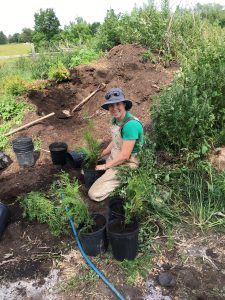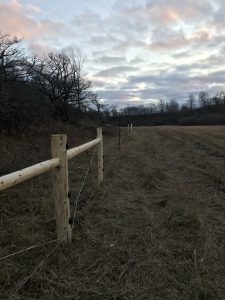Submitted by: Lilian Schaer on behalf of OSCIA
Pam Jackson has always been interested in farming, but it wasn’t until recently that she took the plunge to try to build a farming business of her own on the family farm in Caledon. She grew up on a cow-calf and no-till row crops mixed farm, and the pastures have been empty since her family transitioned out of cattle in the early 2000s as a result of the BSE crisis. At the time, Jackson didn’t see a future for herself in agriculture. However, the growth of a robust local food movement, consumer desire to reconnect with the environment, and her family farm’s proximity to the Greater Toronto Area helped change her mind in recent years.
As a forestry consultant who helps rural landowners with forest management decisions, Jackson’s dream is to turn her family’s farm into a grass-fed beef and ultimately mixed farming operation with rotational grazing.
For the last four years, she’s been growing garlic, building a rotational grazing plan, exploring what she needs to pursue organic certification, and getting the farm ready for her first group of cattle sometime this year.
“The 100-acre home farm is on the Niagara escarpment. It’s very hilly, and the pastures get cut to keep the trees down, but they are underutilized. We also have a provincially significant wetland that runs through the property, as well as hardwood and cedar forests,” she explains. “I love the topography and natural features on this land. It’s really important to me that we protect and even enhance these features as the new farm business is developed.”
A wetland inventory completed by Credit Valley Conservation (CVC) uncovered some rare wetland species on the farm. The property is also home to Eastern Meadowlark, Barn Swallows, Bobolink and Snapping Turtle, all designated species at risk in Ontario.
Jackson first learned about a program called Species at Risk Partnerships on Agricultural Lands (SARPAL) at the Guelph Organic Conference in 2018 and in connecting with Mark Eastman, CVC’s agricultural outreach coordinator.
Delivered by the Ontario Soil and Crop Improvement Association (OSCIA) and funded by Environment and Climate Change Canada, SARPAL provides cost-share support to agricultural producers to implement practices that support habitat for 12 different species at risk. They include American Badger, Barn Swallow, Bobolink, Eastern Foxsnake, Eastern Meadowlark, Eastern Grasshopper Sparrow, Gypsy Cuckoo Bumble Bee, Henslow’s Sparrow, Little Brown Myotis, Loggerhead Shrike, Monarch Butterfly and Rusty-patched Bumble Bee.
With help from SARPAL, Jackson hired an agricultural consultant to develop a rotational grazing plan for the farm. She also cleaned up encroaching trees and shrubs, improved a windbreak, and got 27 acres of forage crop into a delayed haying program to protect grassland birds nesting in the spring.
“We had a sparse hedgerow with invasive species, so we enhanced that buffer of trees and shrubs, created a wildlife corridor and fenced out the cattle,” she says.
Fencing was also the focus of her most recent SARPAL project, which started last year. It included cross-fencing for rotational grazing on nine acres and permanent high tensile fencing to keep cattle out of the farm’s wetland and woodlot. A third of the fencing is yet to go in this spring, but Jackson is hopeful that all of her efforts will ultimately protect and enhance the farm’s ecosystems and species.
“With rotational grazing, the idea is that cattle have a heavy impact on the pasture for a short period of time, and then you move the animals, and the grass can recover in between grazing. When fields are hayed instead of grazed, that’s just nutrients leaving the land,” she says. “I want nutrients to come back and stay to make the soil health better.”
Her long-term vision is to bring trees into the pasture to create a savannah with 20 – 25 percent shade and canopy cover. It’s an ecosystem she believes is most productive, with the trees fixing carbon and bringing nutrients into the soil without hindering grass growth. It will also avoid drought issues, she adds, and the shade will improve cattle welfare.
“With climate change, farmers should be striving to introduce as much resilience into their systems as possible. More than ever, we need our soils to be able to absorb and retain the rain that hits it,” she believes. “Longer periods of drought will be a reality, so when it does rain, we will likely be dealing with heavy rain events that come down hard. If we don’t have healthy, resilient soils, we will be in big trouble.”
SARPAL has been a springboard for Jackson, letting her complete in a few months what would otherwise have taken her years to do. It’s also given her access to expertise she says has been instrumental in bringing more ecological value to the farm.
“This funding has given me the opportunity to connect with the experts that I wouldn’t have realized otherwise. The folks I’ve had the chance to work with on these projects are helpful and encourage you to do the right thing; they work with you and are pragmatic about solutions that will work for your particular farm,” she says.
For more information on SARPAL, please visit:
https://membership.ontariosoilcrop.org/oscia-programs/sarpal/.

